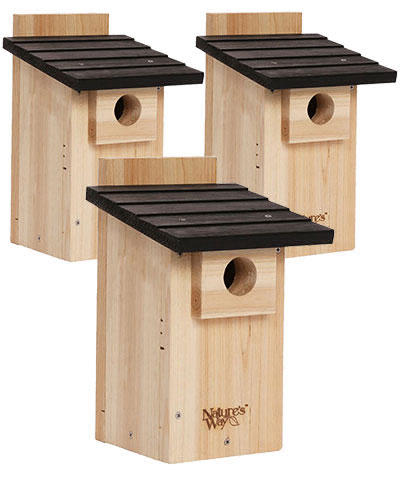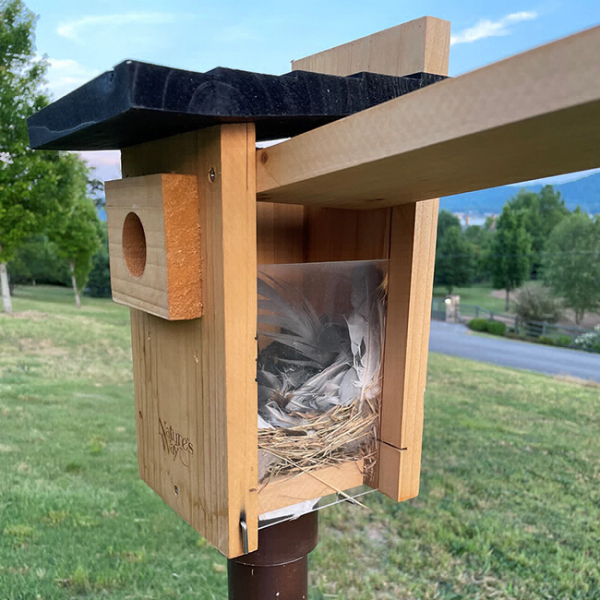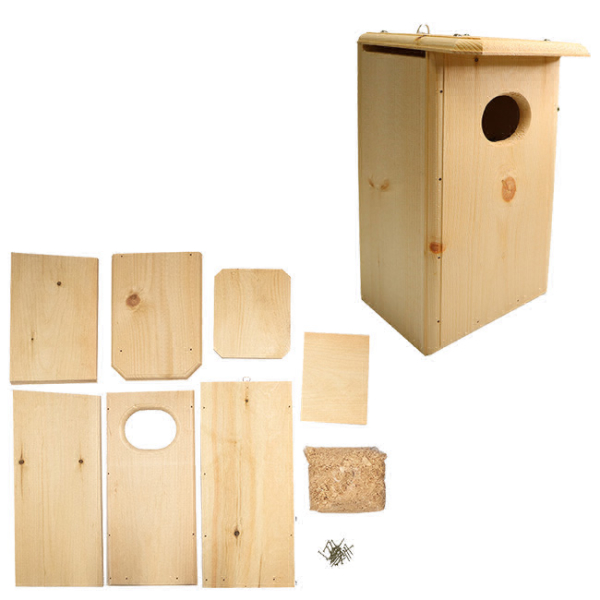
The Cedar Bluebird House with a Viewing Window can be purchased in lots of 1 or 3 from BestNest.

The unique clear plastic viewing window inside the opening panel allows you to easily monitor the progress of nesting birds that use a Cedar Bluebird House with a Viewing Window.

You can choose a ready-made Coveside Wood Duck Box, or buy one to assemble with a young family member.
|
As winter begins to slip into spring, it’s time to prepare for cavity nesting birds in advance of the coming nesting season. Some of our favorite backyard birds are cavity nesters, including bluebirds, wrens, chickadees, titmice, and screech owls – but there is always a shortage of natural cavities and woodpecker-created cavities for birds to nest in. That’s where we birders enter the picture by providing safe, appropriately sized nest boxes and birdhouses (which are the same products with different names).
Beyond our feeding station, which includes a fresh water source, supplying a nest box is the most important thing we can provide. This year we want to be sure that everyone understands that for a given birdhouse to be most effective, and safe for birds to use, there are a few things to look for when buying or building a nest box or birdhouse.
Consider that a nest box is an artificial cavity, suitable for cavity nesting birds to build a nest in, or in the case of owls or kestrels, lay eggs in (they don’t build nests). But an appropriate nest box has some very important features that even a natural cavity may not provide. Hence, you can improve on nature by providing the right nest boxes for our cavity nesting birds.
An extremely useful, simply stated collection of information about each cavity nesting species and the nest box size and habitat requirements they require is succinctly provided at the Cornell Lab’s NestWatch website at NestWatch | Features of a Good Birdhouse - NestWatch Below, we provide a list of what to look for before you buy or build a nest box.
Small & Big – Consider adding a couple small nest boxes and a big nest box to your property to benefit a variety of nesting pairs, that may range from House Wrens to Wood Ducks.
Materials – When building your own nest box, use untreated, unvarnished, unpainted wood; and when buying a birdhouse, check to ensure it is unpainted, untreated, and unvarnished.
Entrance Hole Size – One of the most important considerations when selecting a nest box is the size of the entrance hole. Different birds need different-sized entrance holes, with the intent to keep larger, more aggressive species (starlings and sparrows) from taking over a nest box meant for bluebirds or chickadees, for example. The NestWatch webpage provided above lists entrance sizes for all species of North American cavity nesting birds.
An Opening Panel – One of the things missing from many nest boxes found in hardware stores and department stores is a way to access the inside of the nest box – a feature that is imperative for monitoring, and maintaining any nest box. Access is usually provided by a hinged side of the nest box, but also check for a sturdy closing mechanism so the opening side can’t open unexpectedly.
Make it Predator Proof – An important thing to keep in mind is that if you aren’t protecting the nesting birds from predators, you are merely providing a feeding station for predators. Therefore, when you have your nest box(es) picked out, think about how you will provide predator proofing. Start with how and where you plan to install each nest box. All nest boxes need predator proofing, with an excellent example of a predator baffle being the Wild Birds Unlimited Raccoon Baffle that will stop raccoons, squirrels, cats, snakes, and more; see Advanced Pole System - Wild Birds Unlimited | Wild Birds Unlimited (wbu.com) You can also attach a long piece of stove pipe metal that fits all the way around a larger post or pole to prevent snakes, raccoons, and others from accessing a nest box.
Installation – Even before you buy or build a nest box, it’s important to plan on where you will position it, with reference to protecting it from would-be predators. How you install it, as well as how high you position it are important variables that will dictate what nesting birds will use it, but in the end, it’s also all about habitat.
It’s All About the Habitat – Each species has its own habitat preferences, so check the habitat types preferred by the birds you wish to attract at the NestWatch website. Type in the name of the species you hope to attract for information at NestWatch | Black-capped Chickadee - NestWatch
More to Consider
Ventilation & Drainage – All nest boxes should have slots or holes under the roof to provide simple ventilation on hot days as well as drainage holes on the bottom, just in case water should dribble inside. Then too, if a nest box lacks these features, it’s easy to drill some sizable holes in the top sides and floor of each nest box to provide ventilation and drainage.
Wood Chips – It’s important to add an inch or 2 of wood chips to the bottom of any big nest box. Some birds that utilize big nest boxes don’t build nests, notably owls and kestrels, and cavity-nesting ducks don’t really build a nest beyond the down lining the female builds around her clutch of eggs, so wood chips are a helpful addition.
A Climbing Ladder – Although some nestlings can climb up a rough wooden surface easy enough, it’s helpful to carve grooves into the wood below the entrance hole to create something of a ladder for nestlings that are ready to fledge to climb up to the entrance, or for hatchling ducklings that are ready to leave the nest and follow the female to a nearby pond.
Shopping for Quality Nest Boxes
Let’s start with a best-case example of a nest box or birdhouse: The Cedar Bluebird House with a Viewing Window is one of the best examples of a nest box that has all the details to make it a preferred product, including a screen base and a unique clear plastic viewing window inside the opening panel that allows you to easily monitor nest box activities. This premier nest box is very affordable and available from BestNest at Nature's Way Cedar Bluebird House with Viewing Window at BestNest.com BestNest also offers many other nest boxes and birdhouses.
Another unique option is the EcoTough Rustic Bluebird House from Wild Birds Unlimited, which includes a two-way opening system for easy monitoring and cleaning, complete with ventilation and drainage openings, and it’s constructed with environmentally friendly EcoTough products made from recycled plastic; see Modern Rustic Bluebird House - Wild Birds Unlimited | Wild Birds Unlimited (wbu.com) – and WBU also offers a similar but smaller EcoTough Wren & Chickadee House.
BestNest has what must be the best selection of Big Nest Boxes, including the Coveside Wood Duck Box. This particular big nest box is also available unassembled if you’d like a simple project to construct with young birders; see Coveside Wood Duck House, Unassembled at BestNest.com This nest box may also attract nesting pairs of small owls, kestrels, and other cavity nesting ducks, although there are specific nest boxes built with these birds in mind too at BestNest.
As March 1st approaches, it’s time to take action to benefit cavity nesting birds. Make a plan, select the best nest boxes for the birds you wish to attract and benefit, and position them in appropriate habitat, safe from predators, so you can enjoy observing the ensuing action this spring and summer. Providing nest boxes for cavity nesting birds is more important than ever!
Share your backyard birding experiences and photographs with The Birding Wire at editorstbw2@gmail.com